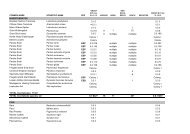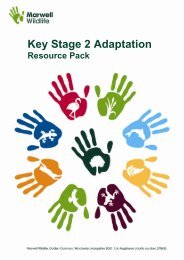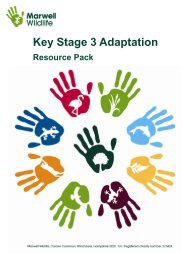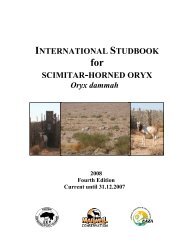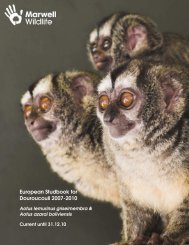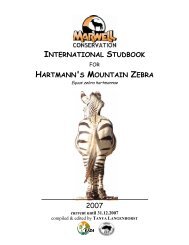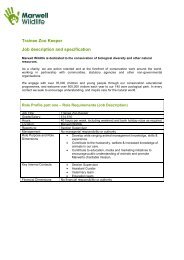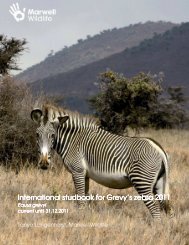international studbook hartmann's mountain zebra - Marwell Zoo
international studbook hartmann's mountain zebra - Marwell Zoo
international studbook hartmann's mountain zebra - Marwell Zoo
You also want an ePaper? Increase the reach of your titles
YUMPU automatically turns print PDFs into web optimized ePapers that Google loves.
Specific pilot project activities to be undertaken:<br />
1) Identify and engage individuals/institutions in Namibia and South Africa for collaboration<br />
- capture/handling/collaring (Ministry of Environment and Tourism)<br />
- data collection and field work (PolyTechnikon and University of Namibia)<br />
- genetic analysis (University of Witwaterstrand, South Africa)<br />
- other parallel <strong>mountain</strong> <strong>zebra</strong> studies (Gondwanaland, Namib Park/Gobabeb Research Center)<br />
2) Collate and assess available data on landscape, resource and human use variables within the study region<br />
- Determine where observational/collaring/fecal sampling efforts should be stratified to obtain a<br />
representative sample of <strong>mountain</strong> <strong>zebra</strong> space use across the range of habitat variables in the study<br />
region.<br />
- Identify any important data/knowledge gaps that exist<br />
3) Establish genetic methods<br />
- Investigate whether days-old <strong>mountain</strong> <strong>zebra</strong> feces contain usable quantities of DNA.<br />
- Determine which genetic markers are the most variable in the northern Namibian <strong>mountain</strong> <strong>zebra</strong><br />
population, and will thus be most useful in the future for identifying individuals.<br />
4) Collect observational and location data on <strong>mountain</strong> <strong>zebra</strong>s and establish appropriate methods for doing<br />
so<br />
- Investigate group sizes, compositions (especially number of foals), and locations in northwestern<br />
Namibia; also attempt to identify dominant grass species present/grazed on by <strong>mountain</strong> <strong>zebra</strong>s.<br />
- If the research team is present during a “critical period” (i.e., drought or early rains), attempt to locate<br />
congregations of <strong>mountain</strong> <strong>zebra</strong>s.<br />
5) Investigate local traditional/expert ecological knowledge<br />
- Obtain existing traditional/expert knowledge about the seasonal movements and locations of <strong>mountain</strong><br />
<strong>zebra</strong>s, particularly during the early rains, across the study area.<br />
- Find out if there is local knowledge of annual patterns in regards to where the animals mate, and where<br />
they give birth during typical and atypical years.<br />
Study Area: The study will focus on the Kunene Region of northwestern Namibia, a landscape that receives<br />
less than 200mm of rainfall, yet supports a full assemblage of free-ranging, native wildlife including<br />
elephant, lion, black rhino and a suite of ungulates. This arid, open landscape also supports local<br />
communities that continue a tradition of livestock herding while embracing consumptive and nonconsumptive<br />
tourism. A strong community-based conservation approach has resulted in a regional mosaic of<br />
defined community groupings or ‘conservancies’ and are implementing various land uses practices to acquire<br />
benefits (mainly economical) from their resources including photo safaris, trophy/subsistence hunting, and<br />
traditional livestock farming. Within this conservancy land matrix, a new “people’s park” of approximately<br />
7,500 km 2 is currently being negotiated, which will secure key wildlife habitat between Etosha National Park<br />
in north-central Namibia and Skeleton Coast National Park in the west. This proposed protected area will be<br />
mainly managed for non-consumptive tourism. This region is also a stronghold for <strong>mountain</strong> <strong>zebra</strong>s, in that<br />
several thousand <strong>zebra</strong>s are thought to occur there.<br />
Project time frame:<br />
If we are able to obtain adequate funding, we will conduct the field work for the pilot project in<br />
Spring 2009. DNA will be extracted from the fecal samples in a wildlife genetics laboratory in Namibia by<br />
mid-late 2009. Quantitative PCR assays and genotyping will be completed in early and mid 2010,<br />
respectively. As soon as quantitative PCR results are available, we can prepare the genetic sampling<br />
protocols for the long-term project and apply for long-term funding. We will prepare 6-month updates on our<br />
project and provide them to all institutions providing funding for this project.<br />
AII





